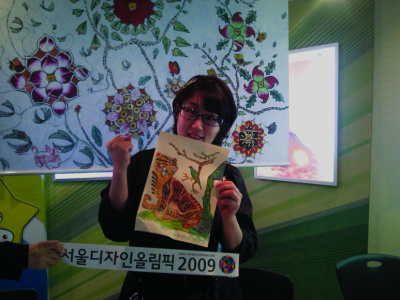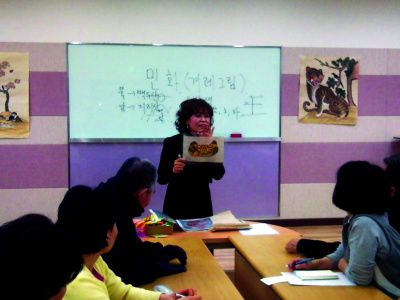
Unfortunately, the precious value of minwha is often forgotten by people when compared to the much appreciated paintings from the West.
To resolve this situation and to introduce the excellence of minwha worldwide, youth have gathered and founded a social venture firm called Minwha Factory in 2009.
“I decided to start the business just with the passion to introduce the beauty of Korean culture to foreigners. Korean education emphasizes too much of western history and culture while somehow neglecting our own culture. I wish the next generation could get a proper education to value our own culture more with the help of my business,” said Im Young-jin, the executive director of Minwha Factory.
Minwha Factory’s main business is to give free lectures about minwha at community centers and schools. Minwha paintings usually contain a depiction of our ancestors’ various hopes like health and affluence with animal figures, or seek to symbolize the essence of eastern philosophies such as Confucianism, thus, Im believes the lecture about minwha shed light on the whole of Korean culture.
The other important objective of Minwha Factory is to give a free lecture about minwha once a week at the Yeongdeungpogu (District) Office to foreigners and immigrant workers in Korea.
“Foreigners are from the completely different environment from here and are required to adopt this culture all of the sudden. I think minwha offers them some opportunity to learn about Korean culture more easily since minwha is a very interesting tool to understand Korean culture,” Im said.

The lectures for foreigners are made with the curriculum, including a Korean language lecture, a theoretical lecture about minwha and a practical minwha painting experience.
“I attended the lecture about a month ago with great interest. It was a perfect chance to have a thorough and systematic understanding of Korean culture. Especially I enjoyed painting minwha on my own based on the knowledge I learned from the lecture. I still have the painting of a Korean tiger in my room. I consider it as my guardian angel,” said Thanh Hung Nguyen an immigrant worker from Vietnam.
International students who wish to participate in the Minwha Factory’s lecture can get further information and enroll for the course by visiting the Web site (http://www.ydp.go.kr/jumin/main.do), although it should be noted, the Web site is only in Korean.
Although the main business of Minwha Factory is to provide free lectures to the community, the concept of this business is differentiated from other volunteer works in a way that it has its own profit model.
“Basically we are a social venture, which means a business that contributes to society by doing its own business. The main profit model of the company is to supply the materials for the minwha paintings at the schools where we teach. I wish to sell some products utilizing minwha, like a necklace with a minwha design in the future but now the company plans to concentrate more on the free lectures to introduce minwha more,” said Im.
For its creative business model and devotion to Korean culture, the company won the competition, “Young Venture 1000 Project” and has received some support for founding the firm in 2009.
“I consider myself lucky to have won the prize among other competitive business models. I regard it as a belief in us to make a great devotion in introducing Korean culture to foreigners. I will do my best in that,” he said.
Shim Su-min
24sumin@ewhain.net

